How and which bathtub is better to choose: overview of options and recommendations for choosing
How to choose a bathtub so that it best suits personal requirements and interior parameters is a fairly common question.After all, the design of the room and the comfort of all users will depend on a rationally made decision.
Not so long ago, finding the perfect option in a store was not an easy task, and in some cases, unrealistic. But the modern market provides an excellent assortment of bathtubs for the most demanding tastes.
In this material we will tell you what to look for when choosing a bathtub, what rules should be followed.
The content of the article:
The main criteria when choosing a bath
There are not so many decisive guidelines when choosing a bath: only three. This set of characteristics includes the shape of the product, the material from which the bowl will be made, its color and size.
We could not ignore the current issue, and decided to devote the most detailed article to it.
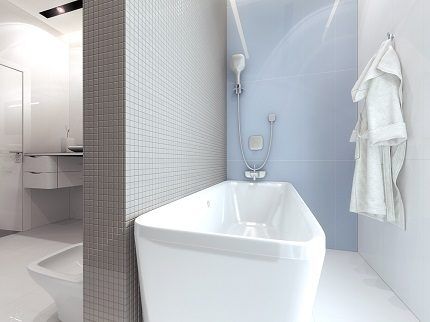
Before you begin to inspect the assortment, you need to clearly determine what you will have to give priority to. So what do modern manufacturers offer us on the market and which bath should we choose?
The first criterion is the material.
The main feature underlying the classification of bathtubs is the material from which the product is made.This is what professionals and specialists mean when they are asked about types.
Many people who need to purchase a new bathtub are often faced with difficult choices. Which bathtub will be better, and which one will last longer and will not lose its appearance - this is the information that interests us.
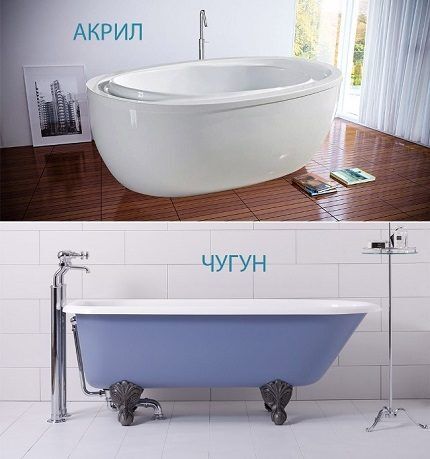
First of all, you need to consider the advantages and disadvantages of bowls of each type of material, find out how the products meet specific personal requirements. How will this bath fit into the existing interior?
Cast iron bathtub - overview and characteristics
Not much time has passed since every living space began to be equipped with a bathroom and a product installed in it made of an iron-carbon alloy. The cast iron bathtub is very strong and durable. It has a high level of heat capacity.
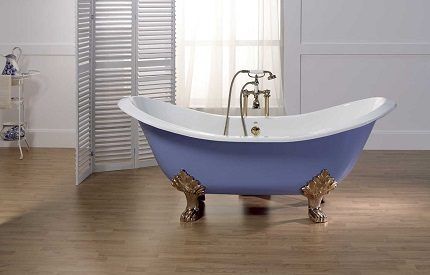
The enamel is resistant to numerous hygienic and sanitary procedures, and to regular exposure to household cleaning products. However, it can relatively quickly lose its original appearance, of course, with improper use and care. The heavy weight complicates the process of transporting the bathtub to the floor.
First cast iron bathtubs appeared a long time ago, but even today they remain one of the most reliable and durable products. Thanks to the application of enamel to the inner surface of the bowl, the bathtub began to look even more aesthetically pleasing.
The enamel is applied in several layers, thanks to which sanitary ware bowls with a glossy and matte finish last a long time and look great.
Modern manufacturers have tried to add silver ions to the enamel structure.This helps purify water when it accumulates. There is no doubt that cast iron bathtub material has a number of advantages and disadvantages. We will get to know them a little later, in the appropriate section.
Steel bath - brief description
Products made from this material are considered the most affordable due to their relatively low cost. Bathtubs made of steel are easy to transport; lifting them to the floor is much simpler and easier. It differs from a cast iron product in its lower heat capacity and the unpleasant noise made when drawing water.
Read about the features of choosing steel bathtubs in this material.
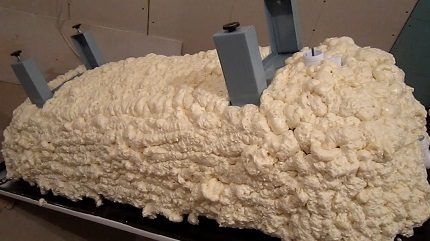
Acrylic bathtub - consumer qualities
Caring for an acrylic bathtub is quite simple. Such products are characterized by excellent thermal technology, low weight and a wide selection of shapes.
If the manufacturer carries out processing using outdated technologies and tries to save on raw materials, then the bath will emit a repulsive chemical odor. This product should not be used for washing pets, as it will quickly scratch.
Acrylic bathtubs have recently gone on sale. But in such a short period they managed to earn the trust of many buyers and rapidly gained popularity. Products made from such material are distinguished by a colossal variety of shapes, which cannot be said about cast iron. The quality of a polymer sanitary ware bowl directly depends on the number and characteristics of the acrylic layers.
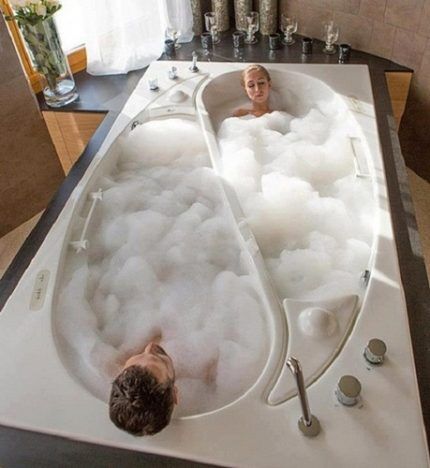
Cast or extruded polymethyl methacrylate is the basis of every acrylic bathtub. To obtain the desired shape, it is necessary to achieve a certain plasticity of the material. And this is possible if the blank sheet is heated to a suitable temperature and a vacuum is applied to it. This is exactly how the process of obtaining the required form occurs.
It is interesting that when finishing giving the material a clear shape, the sheet becomes too thin in the areas that were stretched. This definitely needs to be fixed. Manufacturers use various methods and modern technologies to strengthen such places.
But most often, layers of fiberglass bonded with epoxy resin are applied to the walls of the product.
A metal frame usually provides stability to the bottom of a lightweight, flexible bowl. The frame must be included in the product package of the responsible manufacturer.
If the product is to experience high loads, it is better to supplement the standard frame with brick supports or wooden beams under the bottom, and install a decorative or functional screen on the sides.
It cannot be said that in the production of acrylic plumbing fixtures, dubious campaigns only use acrylic itself. Without an established production cycle, this is too expensive.
Unscrupulous manufacturers simply add synthetic components to the polymer compound that have very good ductility, which also allows the product to be given the desired shape.
The cost of the modified compound is much lower than acrylic, which means that such bathtubs will cost much less, although they are still called acrylic.
We also recommend reading our other article, where we talked about how to choose a good acrylic bath.
Stone, wood and copper baths
Modern products are made from various materials. Some of them are more familiar, while others are relatively new. We are talking about wood, stone, glass, and copper.
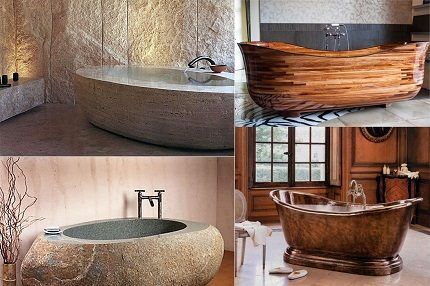
Stone is considered an expensive and very heavy material for the production of bathtubs. Natural products are often seen as a luxury item. At the same time, a bowl made of stone will simply be distinguished by its enormous weight and “unaffordable” price for most.
Before choosing natural stone, you should definitely check the quality of the floors and their ability to hold so many hundreds of kg. A stone bathtub will provide its owner with individuality, luxury and incredible beauty, as well as environmental safety.
Wood, surprisingly, is excellent for making a bathtub or sauna font. Wood guarantees good thermal insulation. And teak wood products will saturate the procedures with aromatic accompaniment.
The main advantage of such a bath is its immunity to corrosion. But a bowl made of this material requires careful care, care with hot water and boiling water, as well as significant financial expenses. If you are a jack of all trades, you can try making a wooden bathtub yourself, and you can read about what you will need for this Here.
A copper bathtub is on the list of the most expensive options when choosing such products. Copper has anti-corrosion properties and is also characterized by the ability to release specific bactericidal acids.
This material does not require additional enamel coating.The metal has exquisite properties and imparts originality and style. Considering luxury options for bathtubs, copper will become a real decoration of any room.
The second criterion is size and shape
The plumbing market offers various levels of product width, length and depth. Based on these parameters, you need to approach the choice of a bath as responsibly as possible. After all, its use can cause various inconveniences and discomfort.

Products come in lengths of 150, 170 and 180 centimeters. If desired, you can find a non-standard bathtub size on the market, for example, 200 centimeters or more. Before you start purchasing, you first need to measure your height, as well as the distance in the room.
The width of the product can be determined based on the build of the people who will use it.Most often, bathtubs are from 75 to 100 cm wide.
The depth of the bowl in many cases is 65 centimeters; there are always exceptions. Now manufacturers offer shallower bathtubs and vice versa. To determine the ideal depth, body parameters, namely the height of each user, should be measured. After all, if while taking a bath your knees stick out, it won’t be very pleasant.
You can read more about standard bath sizes in this article.
Criterion three - additional comfort
Safety and convenience are priority factors for manufacturers of such products.
For example, some cast iron bathtubs have an additional coating on top of the main layer of enamel. This provides protection against slipping and eliminates injuries, which are important for children and adults.
The surface inside the bath may also have an antibacterial coating that contains a small proportion of silver ions. Imported manufacturers make models with armrests, auxiliary supports for the back, handles on the left and right sides, as well as unique pillows for the head.
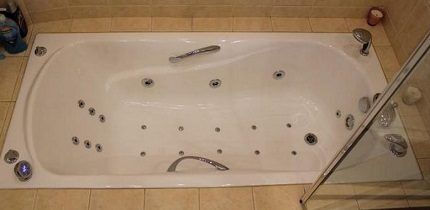
A hydromassage bath is a wonderful invention that gives incredible sensations and relieves fatigue. If you prefer an acrylic bathtub, but still can’t decide which one to choose, a product with hydromassage system will bring a lot of benefits.
For example, it will influence lymph circulation, promote good relaxation of the body, replenish vitality and increase the energy charge of the body.
Each person determines for himself which product suits him best. But before purchasing, you should consider the material, cost and reputation of the company.
Key advantages and most important disadvantages
If you are stuck on choosing the best bathtub and have not decided which one you should choose, then it is better to weigh all the pros and cons. Because the cases are all individual and each buyer has his own requirements, wishes, preferences and financial capabilities.
The main advantages of a cast iron bath
Products made of cast iron:
- They are the most “silent”, and with a normal blow they do not produce an echo. The flowing water is barely audible, in some places even silent.
- Baths made of this material have low thermal conductivity, which allows the water to cool less quickly.
- Ease of maintenance is very characteristic of cast iron. The product with glossy enamel is easy to clean. Dirt does not accumulate on the surface of the bathtub.
- Durability and service life are the main factors that make cast iron bathtubs so popular. And it's not a matter of habit.
The enamel coated product has a pleasant shine. What acrylic doesn't have.
Disadvantages of a cast iron bath
Impressive weight. A bathtub made from this material is almost impossible to lift. This will provide additional hassle associated with transportation and installation of the product.

The enamel is vulnerable and can suffer significant damage from an unexpected fall of a foreign object. It doesn’t matter how high quality it is, if you drop a metal part or just a heavy thing inside, a piece of enamel may break off or cracks may appear.
But such an object must also be either very massive or have a strange shape in order to damage the surface. One way or another, restoring a cast iron bathtub is a common practice.
Form. The choice is very small. The bulk of cast iron bathtubs are made in the shape of a rectangle and there are practically no alternatives to this.
The price of cast iron bathtubs varies greatly depending on the manufacturer, the availability of additional features and, of course, the size.
The most significant advantages of an acrylic bathtub
One of the very first advantages of an acrylic bathtub is its ease of installation. If compared with a cast iron bathtub, the weight of our product will be significantly less. This means that transporting and installing an acrylic bathtub will be less problematic.
Acrylic bathtubs come in absolutely any shape, as well as a variety of colors. You can choose only the color you like. The interesting thing is that all the colors are very durable. Even after many years of constant use, the color will remain the same, since it is set at the stage of formation of the product’s shape.
Acrylic bathtubs are characterized by low thermal conductivity, which allows the water to cool only 1 degree every 30 minutes.
Any minor damage can be easily hidden. To do this, you just need to use one of the repair kits that hardware stores offer in their assortment.
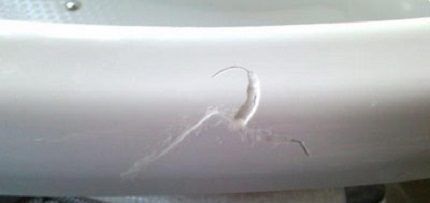
This type of product, although smooth to the touch, is not at all slippery.
Most acrylic bathtubs have several layers of fiberglass reinforcement. If, after much deliberation, the choice fell on an acrylic product, rest assured that the option will last a long time.
Cons of an acrylic bathtub
An acrylic product has a set of disadvantages, like other bathtubs, even though this type is very common and convenient:
- There is still a possibility that acrylic can change color. It is better to try not to pour water into the bathtub after washing, especially from colored laundry.Using bad tap water will most likely cause the bathtub material to turn yellow. Not immediately, but gradually.
- The walls of the bathtub are constantly scratched inside. Damage to the surface of an acrylic bathtub appears much faster than, for example, cast iron ones. As mentioned above, such scratches can be easily fixed.
High-quality acrylic bathtubs cost several times more than cast iron products, but manufacturers of acrylic sanitary ware on average guarantee 10-12 years of operation.
Find out how to choose the best!
Of course, you can turn to professionals, plumbers with extensive experience, so as not to make a mistake.
But you also need to take into account recommendations that will allow you to make the right choice.
We list the most important of them:
- The choice of bathtub should be determined by the level of comfort and characteristics of its functionality.
- Before purchasing, you must make sure that the plumbing system fully matches the selected product.
- Find out whether the siphon is included with the bathtub or whether it needs to be purchased separately.
- Check that it fits into the hole.
- If the bathtub does not have an overflow protection system, you should completely abandon the purchase. Additional flexible plastic hoses are connected to the sewer system.
- If the bathtub has cracks, chips or other damage, its value will be significantly less. It is also not advisable to purchase this option.
- It is better to buy a mixer immediately with the product so that it fully matches the style of the bathtub.
And the last, one of the most significant recommendations is that when buying cast iron, acrylic or other types of products, it is best to do this from well-known manufacturers.In this case, you can fully count on the warranty and service of the equipment.
Conclusions and useful video on the topic
Expert opinions: acrylic or cast iron, what to choose:
A short overview of the main differences between baths:
How and which of the existing bathtubs is better to choose:
How to insulate a bathtub with foam:
If you still haven’t decided on the choice of bathtub, whether to take cast iron or acrylic, here are some more tips. The first is more suitable for modern people who strive for new achievements. It still pays off when the bathtub needs to be dragged to the top floors. Cast iron is more suitable for lovers of durable and environmentally friendly products.
Regardless of the choice, any of the bathtubs described will last a long time with proper care. Whatever model you choose, the product should bring only harmony to your home.
Can you tell us about how you chose the bathtub and what was guided by it? Please share your experience with our readers in the block below.
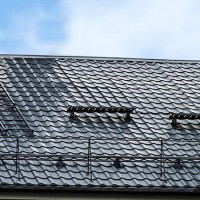



We have a bathroom of 4 sq.m., where there was an ordinary cast-iron vessel. We decided to install a small one to leave room for a laundry basket, etc. As a result, we bought a 1.2 m steel enameled one, I’m very pleased. The amenities of the bathroom remain, but it is easier to clean. We are not fans of soaking, so the size does not interfere. I didn’t notice any sound that was radically different from cast iron.
My husband and I argued for a long time about which bathtub to install. The old cast iron one had already outlived its usefulness, I wanted an acrylic one: it’s lighter, the material is modern, and doesn’t require much maintenance. My husband insisted on a new cast-iron one, saying that they had proven themselves long ago, and the next one would last 100 years.We chose acrylic because we listened to the experts, and they assured that it is easier to install, and in terms of durability it is the same as cast iron, you just need to carefully clean it with special means, and do not rub it too much.
If there is a bathtub, then only cast iron. There are no problems with them and there won’t be any. The most durable and indestructible option, and all these newfangled acrylic ones are definitely not for me.
Cast iron, of course, is indestructible, but why do these bathtubs always turn yellow after a few years? Even modern bathtubs are a problem. How to deal with this?
Hello. It is not cast iron that turns yellow, but its coating due to poor-quality water, incorrectly chosen care products, and poor-quality coating. Recommendations for cleaning a specific coating, regular cleaning of the bathroom and drying it after each wash, and water filters will help you avoid it.
There are options with cast iron oxide, but for this there must be either an uneven protective coating or mechanical damage.
Hello. It is necessary to carry out preventive cleaning of the bathtub with special means every six months at least. Since over time, even on a cast iron bathtub, even on an acrylic one, a coating of dirt and fatty deposits forms, which is impossible not to wash off with plain water. Lime deposits can also form on the surface of the bathtubs. The worse the water quality, the more active limescale will form.
To remove fat deposits, I recommend using Ravak Ceaner (costs about $8).To remove limescale or even rust, it is better to use the inexpensive but practical Sarma Anti-Rust product (costs 1-1.5 dollars).
As for yellowness, it is not the cast iron that turns yellow, but its coating due to poor-quality water, incorrectly chosen care products, and poor-quality coating. Recommendations for cleaning a specific coating, regular cleaning of the bathroom and drying it after each wash, and water filters will help you avoid it. There are options with cast iron oxide, but for this there must be either an uneven protective coating or mechanical damage.